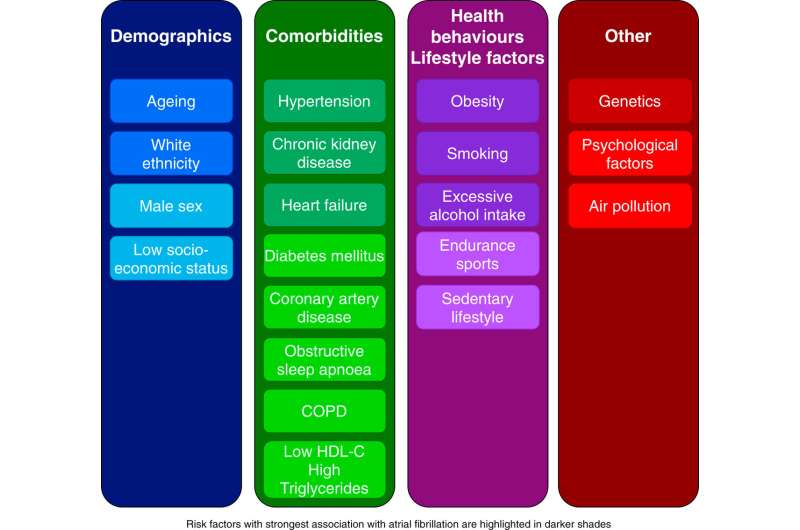This article has been reviewed according to Science X's editorial process and policies. Editors have highlighted the following attributes while ensuring the content's credibility:
fact-checked
trusted source
proofread
Review seeks to understand and manage risk factors for common heart condition

A large-scale review published in The Lancet Regional Health—Europe provides an update on the recent advances in understanding and managing risk factors for atrial fibrillation (AF).
AF is a heart condition that causes an irregular and often abnormally fast heart rate and is the most common heart rhythm disturbance, affecting around 1.4 million people in the UK.
From researchers at the University of Liverpool and Seoul National University College of Medicine, Korea, this meta-analysis of European and global data includes a discussion of lifestyle, somatic, psychological and socioeconomic risk factors.
Corresponding author the University of Liverpool's Dr. Eduard Shantsila said, "Modern anticoagulation therapy has dramatically reduced the risk of stroke and systemic thromboembolism in people with AF."
"However, AF still impairs quality of life, increases the risk of stroke and heart failure, and is linked to cognitive impairment. We wanted to help address the need for a more comprehensive understanding of risk factors predisposing to the development of this arrhythmia, its' complications and interventions to mitigate these risks."
The researchers found that:
- A sedentary lifestyle is a risk factor for the development of AF, and high-intensity interval training improves functional capacity and quality of life in AF.
- Obesity increases the risk of AF, while weight loss reduces AF recurrence and symptoms.
- There is a linear dose–response relationship between alcohol use and AF risk.
- Hypertension is associated with a 1.7–2.5-fold increased risk of AF, which can be reduced by antihypertensive therapy.
- Diabetes mellitus is associated with a 1.28-fold increased relative risk of incident AF.
- A history of myocardial infarction increases the risk of AF by 60–77%.
- Chronic obstructive pulmonary disease doubles AF risk.
- Men are usually reported to have a 30–70% higher prevalence of AF than women, but the lifelong risk of AF is similar.
- White people more often develop AF than people of South Asian and Black origin.
Dr. Shantsila, who conducted this research alongside University of Liverpool colleagues Professor Deirdre Lane and Professor Gregory Lip said, "The findings call for a practice shift towards a more individualized approach considering an increasingly broader range of health and patient factors contributing to AF-related health burden."
"The review highlights the needs of people living with co-morbidities (especially with multimorbidity), polypharmacy, and the role of the changing population demographics affecting the European region and globally."
More information: Eduard Shantsila et al, Atrial fibrillation: comorbidities, lifestyle, and patient factors, The Lancet Regional Health—Europe (2024). DOI: 10.1016/j.lanepe.2023.100784




















